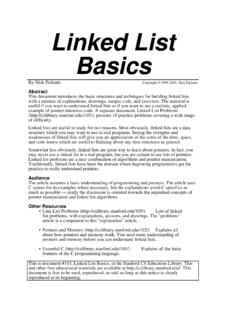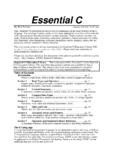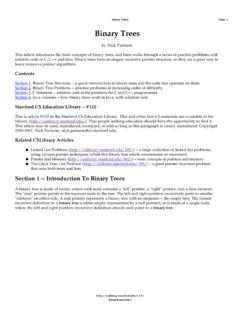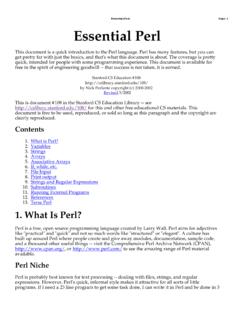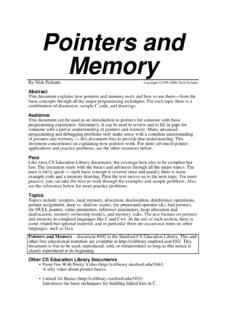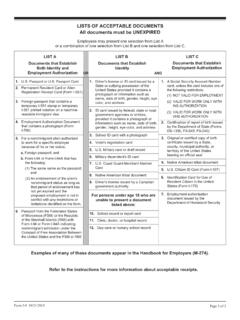Transcription of Linked List Problems - Stanford University
1 Linked List Problems By Nick Parlante Copyright 1998-2002, Nick Parlante Abstract This document reviews basic Linked list code techniques and then works through 18. Linked list Problems covering a wide range of difficulty. Most obviously, these Problems are a way to learn about Linked lists . More importantly, these Problems are a way to develop your ability with complex pointer algorithms. Even though modern languages and tools have made Linked lists pretty unimportant for day-to-day programming, the skills for complex pointer algorithms are very important, and Linked lists are an excellent way to develop those skills.
2 The Problems use the C language syntax, so they require a basic understanding of C and its pointer syntax. The emphasis is on the important concepts of pointer manipulation and Linked list algorithms rather than the features of the C language. For some of the Problems we present multiple solutions, such as iteration vs. recursion, dummy node vs. local reference. The specific Problems are, in rough order of difficulty: Count, GetNth, DeleteList, Pop, InsertNth, SortedInsert, InsertSort, Append, FrontBackSplit, RemoveDuplicates, MoveNode, AlternatingSplit, ShuffleMerge, SortedMerge, SortedIntersect, Reverse, and RecursiveReverse.
3 Contents Section 1 Review of basic Linked list code techniques 3. Section 2 18 list Problems in increasing order of difficulty 10. Section 3 Solutions to all the Problems 20. This is document #105, Linked List Problems , in the Stanford CS Education Library. This and other free educational materials are available at This document is free to be used, reproduced, or sold so long as this notice is clearly reproduced at its beginning. Related CS Education Library Documents Related Stanford CS Education library Linked List Basics ( ). Explains all the basic issues and techniques for building Linked lists .
4 Pointers and Memory ( ). Explains how pointers and memory work in C and other languages. Starts with the very basics, and extends through advanced topics such as reference parameters and heap management. Binary Trees ( ). Introduction to binary trees Essential C ( ). Explains the basic features of the C programming language. 2. The Great Tree List problem ( ). Presents the greatest recursive pointer problem ever devised. Why Linked lists Are Great To Study Linked lists hold a special place in the hearts of many programmers. Linked lists are great to study Nice Domain The Linked list structure itself is simple.
5 Many Linked list operations such as "reverse a list" or "delete a list" are easy to describe and understand since they build on the simple purpose and structure of the Linked list itself. Complex Algorithm Even though Linked lists are simple, the algorithms that operate on them can be as complex and beautiful as you want (See problem #18). It's easy to find Linked list algorithms that are complex, and pointer intensive. Pointer Intensive Linked list Problems are really about pointers. The Linked list structure itself is obviously pointer intensive.
6 Furthermore, Linked list algorithms often break and re-weave the pointers in a Linked list as they go. Linked lists really test your understanding of pointers. Visualization Visualization is an important skill in programming and design. Ideally, a programmer can visualize the state of memory to help think through the solution. Even the most abstract languages such as Java and Perl have layered, reference based data structures that require visualization. Linked lists have a natural visual structure for practicing this sort of thinking.
7 It's easy to draw the state of a Linked list and use that drawing to think through the code. Not to appeal to your mercenary side, but for all of the above reasons, Linked list Problems are often used as interview and exam questions. They are short to state, and have complex, pointer intensive solutions. No one really cares if you can build Linked lists , but they do want to see if you have programming agility for complex algorithms and pointer manipulation. Linked lists are the perfect source of such Problems . How To Use This Document Try not to use these Problems passively.
8 Take some time to try to solveeach problem . Even if you do not succeed, you will think through the right issues in the attempt, and looking at the given solution will make more sense. Use drawings to think about the Problems and work through the solutions. Linked lists are well-suited for memory drawings, so these Problems are an excellent opportunity to develop your visualization skill. The Problems in this document use regular Linked lists , without simplifcations like dummy headers. Dedication This Jan-2002 revision includes many small edits.
9 The first major release was Jan 17, 1999. Thanks to Negar Shamma for her many corrections. This document is distributed for the benefit and education of all. Thanks to the support of Eric Roberts and Stanford University . That someone seeking education should have the opportunity to find it. May you learn from it in the spirit of goodwill in which it is given. Best Regards, Nick Parlante -- 3. Section 1 . Linked List Review This section is a quick review of the concepts used in these Linked list Problems . For more detailed coverage, see Link List Basics ( ) where all of this material is explained in much more detail.
10 Linked List Ground Rules All of the Linked list code in this document uses the "classic" singly Linked list structure: A single head pointer points to the first node in the list. Each node contains a single .next pointer to the next node. The .next pointer of the last node is NULL. The empty list is represented by a NULL head pointer. All of the nodes are allocated in the heap. For a few of the Problems , the solutions present the temporary "dummy node" variation (see below), but most of the code deals with Linked lists in their plain form.
